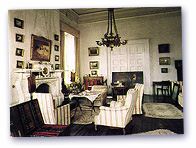 |
Search the site:

Lissadell House, County SligoFew houses have such colourful associations as Lissadell - the large and austere Grecian Revival home of the Gore-Booth family, beautifully situated amidst woods and glades on the north shore of Sligo Bay and immortalised by William Butler Yeats in his poem 'In Memory of Eva Gore-Booth and Con Markiewicz'. As a young man Yeats spent many happy days here with Eva, whom he likened to a gaZelle, and Constance, the 'acknowledged beauty of the county'. In later years he fondly remembered the lofty bright rooms of Lissadell with their 'great windows open to the south' and the 'great sitting room as high as a church and all things in good taste'. The old rooms and furnishing remain, their grandeur a little faded now but steeped in remembrance of the many remarkable people who have lived here. remain, their grandeur a little faded now but steeped in remembrance of the many remarkable people who have lived here.
The Gore-Booths stem from an Elizabethan soldier settler, Sir Paul Gore, ancestor of the Earls of Arran. The Sligo branch first settled at nearby Ardtermon Castle (now restored) but in the eighteenth century moved tb a house near the shore at Lissadell. Unfortunately, the damp situation and the danger from high tides was always a problem, so in 1833 Sir Robert Gore-Booth, fourth Bart (1805-76), commissioned the experienced London architect Francis Goodwin (178 1835) to design the present house. The conservative tastes of both patron and architect resulted in the adoption of a chaste neo-classical design - the last time this style was used for a large country house in Ireland. The exterior walls of grey Ballysodare limestone incor porate very little ornament apart from corner pilasters and a strong horizontal frieze, while the treatment of the interior is similarly austere, though relieved by a wonderful sensation of bright light and space pervading the rooms. A porte cochère with big oak doors gives access to a broad flight of steps leading up to the front hall - a lofty two-storey room with square Doric columns below and Ionic columns above. Kilkenny marble is used for the floor and also for the magnificent double staircase, notable for its iron balusters decorated with winged birds. Beyond the hall in the core of the house lies an enormous apse-ended gallery sixty-five-feet long lit by skylights and a clerestory with tall Doric pilasters along one side and freestanding lonic columns along the other. It was once the music room and retains its original Gothic chamber organ pumped by bellows in the basement. There is also a walnut-topped grand piano, old masters on the walls and souvenirs collected by Sir Robert Gore-Booth on his many travels abroad. His son Sir Henry Gore (1843-1900) was also a great explorer, and in this room stands a model of his yacht Kara on which he rescued his friend Leight Smith from the Arctic ice. It is said that Sir Henry's wife Georgina built the artificial lake at Lissadell in the vain hope that he might stay at home and fish in it, but as the harpoons and whale bones in the billiard room testify, Sir Henry was interested in much larger game. > > > Read the next part of this article From the Appletree Press title: Irish Country Houses.
|
All Material © 1999-2005 Irelandseye.com and contributors
